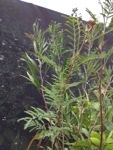A is for Acacia Melanoxylon
Am I really starting this blog with acacia melanoxylon? It just popped into my head. Well more than that, really… I took some photos of it today at Fairhill native plant nursery. It’s commonly known as black wattle, or Australian blackwood, and is a very common pioneer plant. Grows like a weed (it’s actually on the global invasive species list)… And recently I read that the bark was traditionally used for making string and for fishing lines… So I’m starting my blog with a fibre I haven’t actually tested out yet, starting with an item of hearsay, as such. Going on printed information. Oh well, so be it. Acacia Melanoxylon. If I were to take an educated guess, I would suggest that the bark is best peeled off an immature shoot or sapling, as generally the young parts yield the best fibre for string and net-making. My next enquiry would be whether the inner bark could be separated from the outer, as can be done with the cotton tree bark, or not. The inner bark is often finer, less rough, and beautiful. But since I haven’t tested it yet, it’s just a guess.
Here’s a photo of it –
Ok, it’s a terrible photo too, but just wait, I have some magnificent ones in the pipeline…!
A is also for Alexandra palm, Archontophoenix cunninghamii, Araucaria heterophyllis, Aristolochiacea and Anigozanthos, but not… yet.













That is not Acacia melanoxylon in your picture. It is commonly called blackwood, not black wattle which is a different species, or rather species (plural) as that common name is used differently in different locales. Hope this is helpful
Oooh! Thanks! I appreciate helpfulness! Haven’t looked at this list in a long time and certainly didn’t realise my mistake. Thanks!